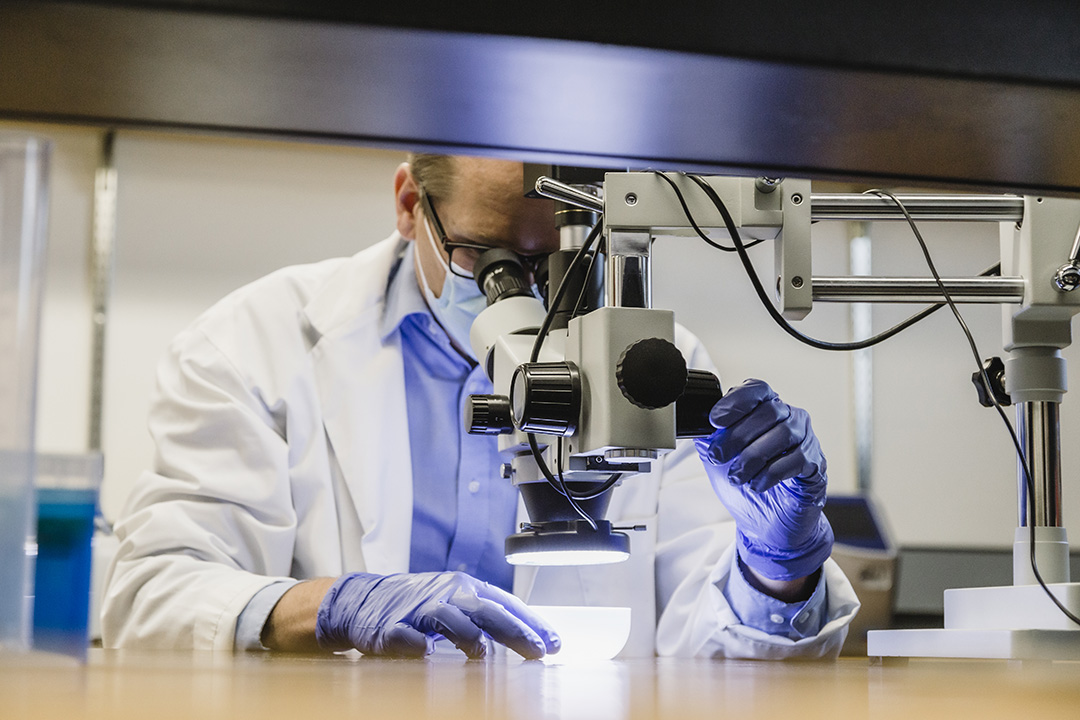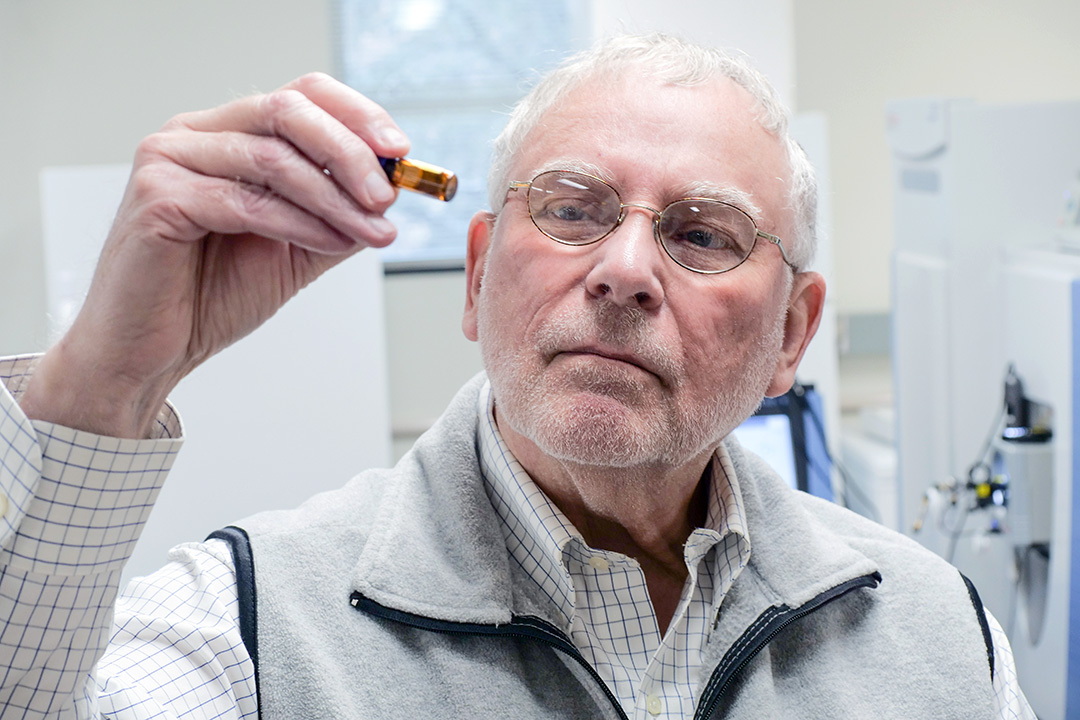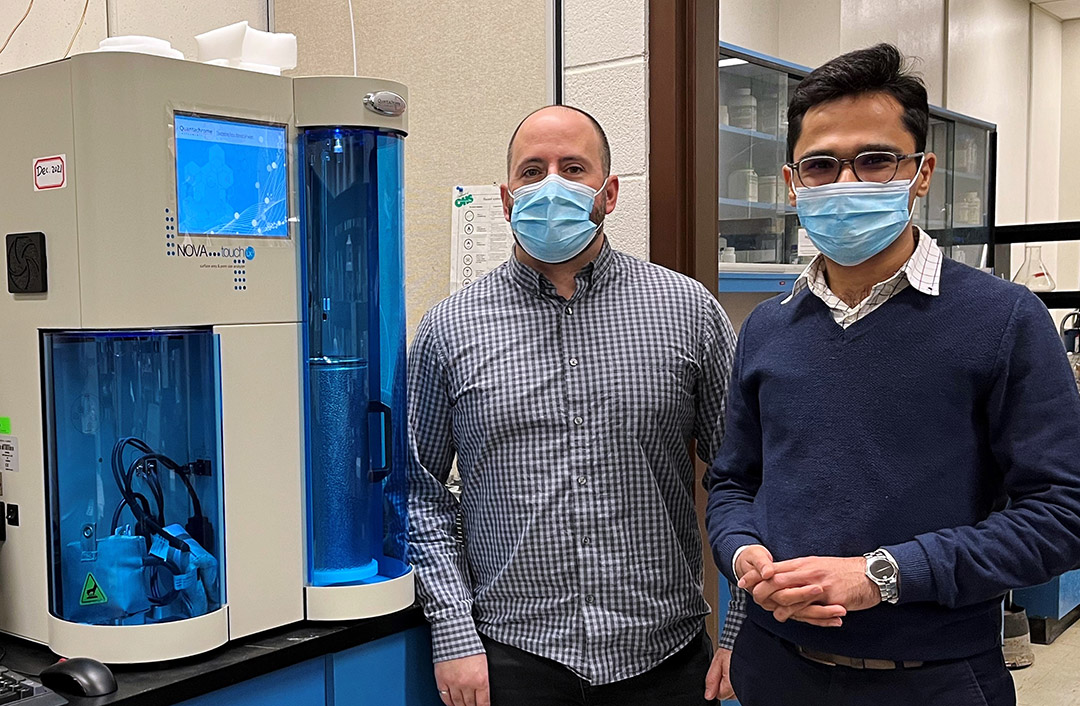
USask wastewater testing for COVID-19 sets the standard
Oh, the stories wastewater streams can reveal about life in a community.
By Sarath PeirisJust ask University of Saskatchewan (USask) researchers Drs. Markus Brinkmann (PhD), John Giesy (PhD) and Kerry McPhedran (PhD), who have been analyzing wastewater and stormwater flows in Saskatoon, Prince Albert, North Battleford, and five First Nations communities, to uncover many of those stories.
Their findings encompass everything from infectious diseases to biomarkers for such conditions as diabetes and heart disease, to the consumption of recreational drugs in a community. The analyses can even provide information on such things as how much red meat a community consumes or pinpoint a city block where a crack house is located.
Since the arrival of SARS-CoV-2 (COVID-19) in Saskatchewan, the researchers have been busy measuring concentrations of genetic material (RNA molecules) in wastewater. The virus is present in the feces of infected persons, even before they become symptomatic.
Because the analysis provides a cost-effective, efficient and integrative measure of infected persons in the sewer-shed, it can reliably project trends in a community approximately seven to 10 days sooner than by public clinical testing.
Other team members are toxicologist Dr. Paul Jones (PhD), USask Toxicology Centre post-doctoral fellow Dr. Yuwei Xie (PhD), engineering PhD student Mohsen Asadi, and research associates Dr. Femi Oloye (PhD) and Jenna Cantin.
Now, propelled by a fifth wave of the pandemic with high caseloads resulting from the highly contagious Omicron variant, public COVID-19 testing sites again have been overwhelmed, leaving many potentially infected persons unable to receive a PCR test to confirm their illness. The government has responded by having citizens self-diagnose using rapid antigen tests, which means many positive cases are excluded from publicly reported figures.

That leaves USask’s wastewater analysis, with its findings presented on an online “dashboard”—put together free of charge to the project by a team at the Global Institute for Water Security (GIWS) at USask—as the most reliable indicator of status and trends for the virus. The project has gained a lot of attention from media, decision-makers and the public.
As well, a separate project put in place by the team in collaboration with USask’s Pandemic Response and Recovery Team (PRT) to monitor wastewater from the university’s student residences for the presence of COVID-19, has also garnered local interest.
Lead-up to COVID-19 analysis in wastewater
Well before COVID-19 arrived, researchers and students from USask’s Toxicology Centre were collaborating with Saskatoon’s wastewater treatment plant staff on wastewater-related projects. These ranged from identifying recreational drugs and pharmaceuticals in wastewater to measuring emissions of greenhouse gases such as methane from the plant.
Brinkmann, assistant professor in the School of Environment and Sustainability at USask, and McPhedran, an environmental engineer and associate professor in USask’s College of Engineering, have collaborated with the city on several stormwater projects, including a couple of studies funded through the Natural Sciences and Engineering Research Council of Canada.
“Oftentimes the city is very engineering-oriented, and they contacted Kerry to say they’d like to work to be prepared for any future regulations on the quality of stormwater discharges,” said Brinkmann.
“He worked on measuring heavy metals, that sort of thing. I could measure several other toxicants and our lab could do toxicity tests. The research on stormwater and wastewater kind of evolved from that,” said Brinkmann, who describes the partnership as a great team.
“We like to work in teams on socially relevant issues and solve problems. Our role is to develop technologies that can be transferred to the private and public sectors and train the next generation of water quality experts,” said Giesy.
Research Junction, a partnership between USask and the City of Saskatoon, has been an effective model, said Brinkmann. That partnership was recognized with the 2021 Smart 50 Award from the Smart Cities Connect Foundation and US Ignite.
Of two recently announced research projects, Brinkmann leads one that monitors stormwater for a toxic compound shed by rubber tires to study its impact on aquatic life—particularly fish species such as trout that are commercially, recreationally, and culturally important.
The other, co-led by Toxicology Centre researchers Dr. Natacha Hogan (PhD) and Dr. Markus Hecker (PhD), studies the impact on several fish species of emerging new antimicrobials used to sanitize homes, hospitals, and other sites, and then are carried by wastewater to rivers and lakes.
The strong relationship forged by USask researchers and graduate students with the treatment plant staff over the years enabled Brinkmann, McPhedran, Giesy and their research team to transition quickly into the COVID-19 testing project, with plant operator and USask alumnus Mike Sadowski an eager collaborator.
“Mike and we basically heard at the same time from around the world that you can measure the virus causing COVID in wastewater. So, we quickly asked each other to see if we should try doing that, and it worked out pretty well,” said Brinkmann.
COVID-19 testing comes on stream
The virus tracking project began with a limited budget, with some funds pivoted away from an ongoing project funded by the Global Water Futures (GWF) program and leveraging technology and equipment to monitor for the virus in wastewater.
Giesy, former Canada Research Chair in Environmental Toxicology, and Xie, who also works on the GWF eDNA program, quickly developed a comprehensive system for detecting COVID-19 in wastewater in July 2020.
The accuracy of their method was validated in a study with eight other laboratories across Canada, co-ordinated by the Canadian Water Network and the Public Health Agency of Canada’s National Microbiology Laboratory in Winnipeg.
Longer term funding for the project, however, remained a problem.
“We made applications and waited quite a while for a response from the province, which eventually declined to fund us,” said Giesy. “The day after, we got a call from PHAC saying they heard the news and asked us to send them a budget.”
PHAC’s requirements to fund the project stipulated it also include five First Nations communities.
McPhedran, as Saskatchewan Centennial Enhancement Chair in Water Stewardship for Indigenous Communities, works with more than 30 First Nations. The team partnered with the Indigenous Technical Services Co-operative, enlisting the Saskatoon Tribal Council, File Hills Qu’Appelle Tribal Council, Agency Chiefs Tribal Council, Touchwood Agency Tribal Council, and Yorkton Tribal Council.
Researchers receive wastewater samples three times per week from the cities. The plants use automated composite samplers located at the inflow of the plants, with the computer-controlled devices sucking up a few millilitres of wastewater every 10 minutes or so into refrigerated bottles that fill up over 24 hours to be then taken to the lab.
These communities often have very few staff to collect samples, and it takes a significant investment by communities to ensure the samples are collected at the right time, preserved properly, and shipped to the lab quickly, ideally within 24 hours, he said. Three communities have been providing samples regularly, and a fourth recently began doing it.
“This is an RNA virus that degrades quickly in wastewater, so how the treatment is done and where the samples are taken are really important,” said Giesy. “Markus and I aren’t wastewater engineers, but the engineering side of things is really important. We rely on Kerry to tell us what we should do.”
With the arrival of Omicron, PHAC called to ask if the team had plans to measure it. The researchers developed a targeted method to identify the variant. As before, the analysis is done in Giesy’s Biosafety Level 2 lab, with samples sent to the National Microbiology Laboratory in Winnipeg for confirmatory genetic sequencing.
“Omicron has several dozens of mutations, and many of them on the spike protein which makes it important as a target,” said Brinkmann. “It’s almost impossible to detect all of them simultaneously with our methods. We pick mutations that are not found in any of the other variants. To be 100 per cent sure that you are picking up Omicron and not a random new mutation, you still have to go through the sequencing.”
The results are shared in a report to the city, public health officials, PHAC, and the public via the dashboard.
Renewed global interest in wastewater analysis
“It’s quite exciting. Wastewater, in many ways, is undergoing a renaissance,” said Brinkmann, who left Aachen University in Germany in 2016 to join USask, attracted by what he terms the university’s “toxicology wonderland” that boasts great research infrastructure and top-notch colleagues.
“There used to be a lot of wastewater research back when there were piles of foam on water bodies caused by phosphate-rich soap in effluent, and algal blooms downstream from wastewater treatment plants,” he said.
“Those problems have been mostly solved, but others not,” Brinkmann said. “Now, when we look at pharmaceuticals for example, many basically go through treatment plants untreated. These drugs are made to change something in humans, so a lot of those processes also cause very similar effects in fish. That makes wastewater very interesting from a toxicological perspective.”
Giesy, professor of biomedical sciences at USask’s Western College of Veterinary Medicine, said wastewater research started around the time he joined the university in 2006 and learned that water quality was an issue in Saskatchewan.
“A lot of cities in Saskatchewan didn’t have active wastewater treatment and used lagoons. One of the big issues was a massive algal bloom in Diefenbaker Lake, which supplies water for almost everyone in the province,” Giesy said. “We were asked to look at that, and one of the big issues was nutrient inputs from wastewater.”
Work to address the nutrient issue in the lake led to helping on the drinking water side of things—studying hazardous algal blooms, measuring concentrations of some of their toxic products, and helping with the design of treatment processes. Next came the request to study the wastewater treatment processes in Regina, where the receiving waters of Wascana Creek in the summer was almost 100 per cent effluent, Giesy said.
“We did some field investigations, and then we were asked to do a before-and-after study to demonstrate the efficacy of the upgrade Regina did on the treatment plan. It worked out really well.”
Post-COVID-19 plans in the offing
Giesy said PHAC has approached the team to talk about plans for a future when the seemingly unending pandemic finally subsides, at least to an endemic illness in the population.
The wastewater project has now been incorporated as the Prairie Node in a National Monitoring Program co-ordinated and funded by PHAC. The federal agency will be funding chemical analyses and extend the current virus monitoring project by six months, Giesy said.
“Now that groups across Canada have all this equipment and trained a lot of people who have become experts in monitoring pathogens in wastewater, it would be very smart to keep these things going and monitor for other diseases that have been plaguing us for a while,” said Brinkmann.

These include regular influenza that kills lots of people in Canada, and other infections especially prevalent in Saskatchewan, such as syphilis, HIV, and tuberculosis in the North, he said. As well, with small communities in particular struggling to deal with a deadly toxic drug epidemic, tracking drugs in wastewater can provide communities advance warning to prepare for problems.
“My interest in wastewater is from a toxicological perspective and, increasingly, from a public health side of things because these things are interconnected,” he said.
“We have to understand why and how drugs are used, not just recreational drugs but also pharmaceutical drugs like beta blockers and antidepressants. We can’t understand the impacts we have on the environment without understanding the societal use of chemicals properly.”
For McPhedran, a concern is untreated effluent containing the COVID-19 virus entering lagoons, which basically look like ponds and act as gathering places for waterfowl and animals such as deer. He wonders about the virus take-up by wildlife creating a zoonotic backlash that might infect humans in the future.
USask residence monitoring a public service project
When USask’s PRT contacted McPhedran and Brinkmann in spring 2021 for help with safely reopening campus last September, they were happy to pitch in.
“We get a lot of negative results from the dorms, and it’s not a research aspect per se, but it’s service we are providing to the community to open the university as safely as possible,” said McPhedran.
Brinkmann said they worked up a small budget at a very reasonable cost for the project, and the monitoring will continue at least until June this year.
Since using the comprehensive computerized sampling process would be too costly at $10,000 or so for each sampler, the researchers use a passive sampling method that would provide round-the-clock monitoring that maximizes the chances of catching the occasional case likely to be in a dorm.
The 3D-printed cigar-shaped device, known as a torpedo sampler, is dipped under wastewater and sits there to accumulate virus RNA over 24 hours. Enclosed inside the tube is a membrane that has an affinity for RNA, and next to it is cotton swab to grab some of the particulates.
USask then uses a platform supplied by the company LuminUltra to determine the amount of virus RNA in these samples. The company stays in touch regularly and has been providing updated instruments free of charge because it feels keeping students safe is important, Brinkmann said.
“We work very closely with USask Facilities folks, who collect all the samples for us five days a week. That’s a great story how administrators in the PRT, us as researchers, and folks in Facilities come together to solve a problem,” Brinkmann said. “It’s a nice success story of how a need is being filled quite quickly.”
Charles Lytle, a Facilities employee who is on a crew collecting the samples from dorms, says they open manholes on nearby streets to collect them early in the day, with the biggest challenge on winter days involving manhole lids freezing up, steam rising from the opening obscuring visibility, and a torpedo occasionally getting stuck in a wastewater pipe, requiring someone to climb down to dislodge it.
“It’s good to know if and when there are any problems in the residences,” he said. “The work done to keep people safe is impressive.”
For more information, watch: COVID-19 and our water supply and COVID-19 in our wastewater?

